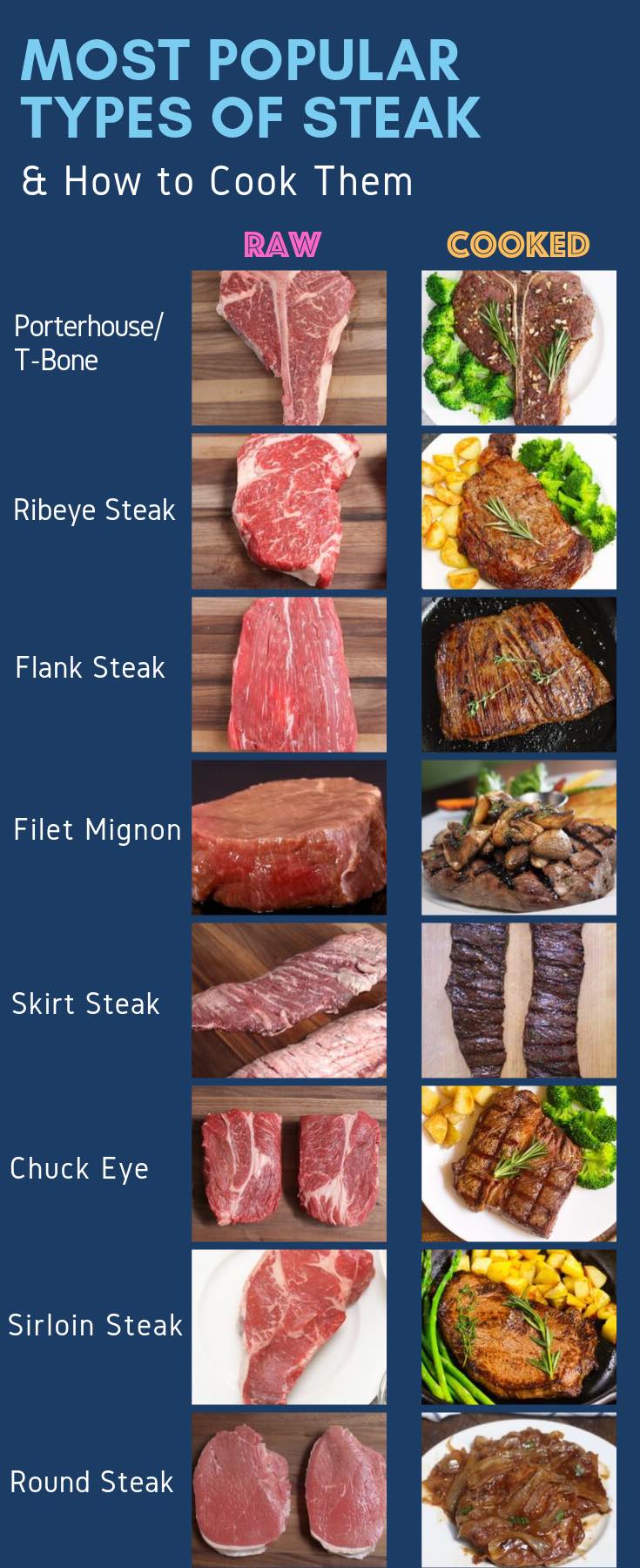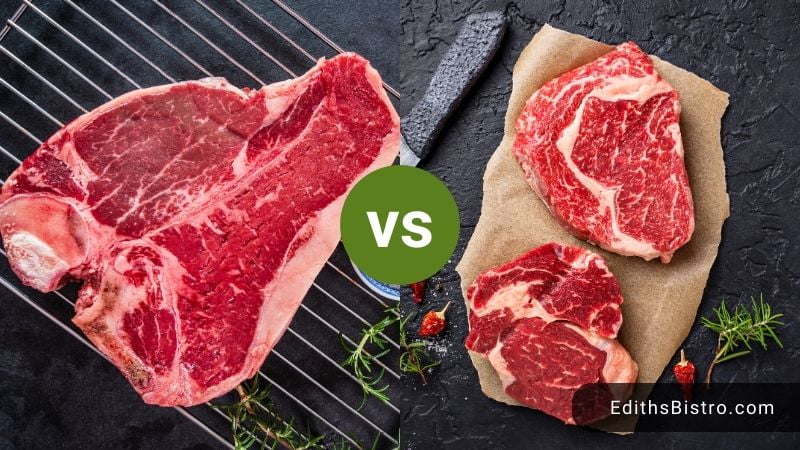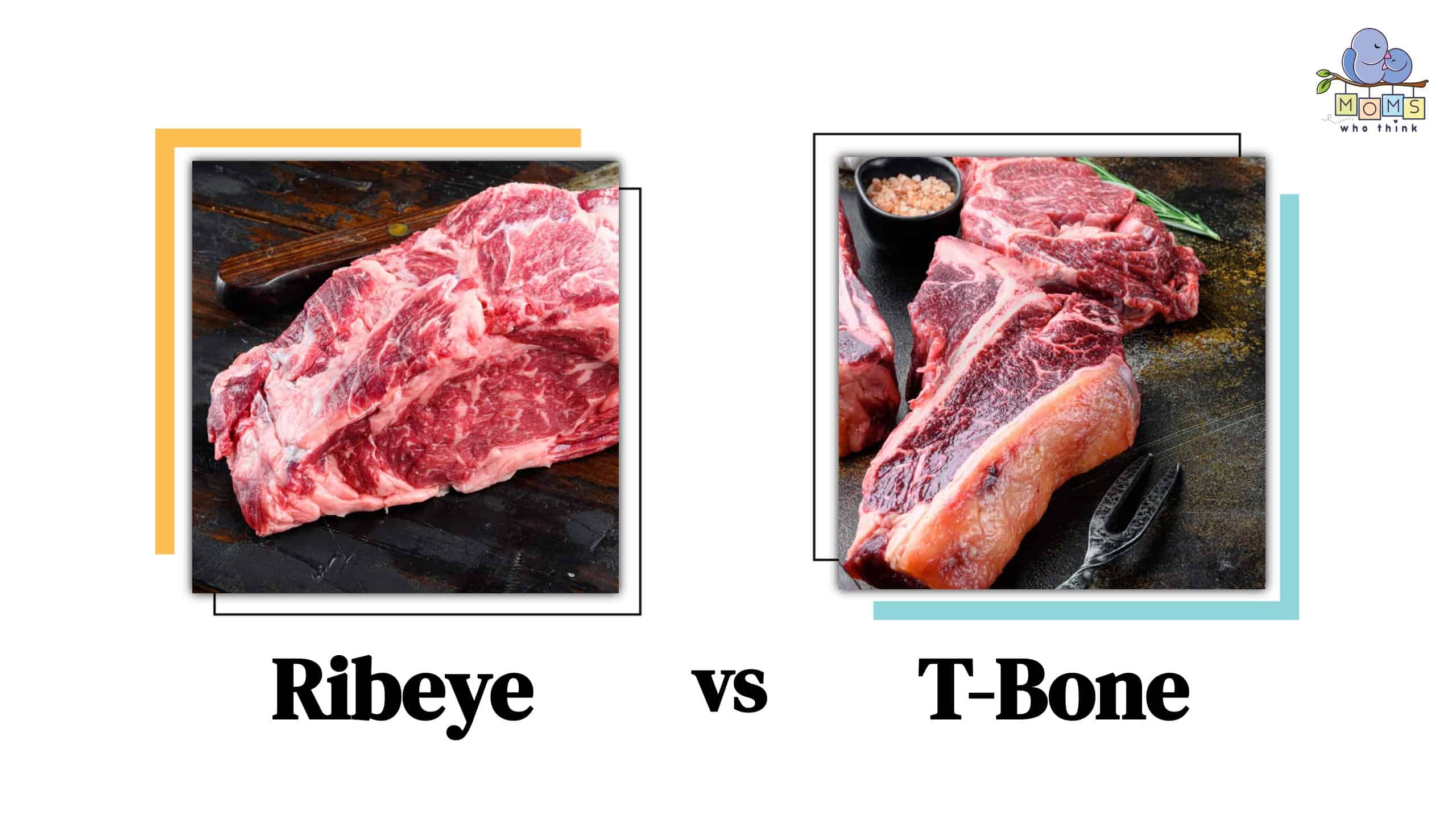
Introduction
When it comes to choosing the perfect cut of steak, two popular options that often come up are the T-bone and ribeye steaks. Both are known for their rich flavor and tenderness, but they do have some distinct differences. In this blog post, we will explore the origin and popularity of these steaks and highlight the key factors that set them apart.
Origin And Popularity Of T-bone And Ribeye Steaks
The T-bone steak originates from the short loin area of the cow, which is located between the rib and the sirloin. It gets its name from the T-shaped bone that divides the steak into two sections—the tenderloin and the strip steak. This combination of tenderloin and strip steak offers a delightful blend of tenderness and robust flavor. T-bone steaks are quite popular due to their versatility and moderate price compared to other premium cuts.
On the other hand, the ribeye steak comes from the cow’s rib section. It is well-marbled with fat, which gives it a rich and buttery flavor. The ribeye is known for its exceptional juiciness and tenderness, making it a favorite among steak lovers.
Difference Between T-bone And Ribeye Steaks
Here are some key differences between T-bone and ribeye steaks:
- Cut: The T-bone steak consists of two distinct cuts—the tenderloin and the strip steak—separated by a T-shaped bone. In contrast, the ribeye steak is a single cut from the rib section of the cow.
- Flavor and tenderness: Both steaks offer excellent flavor and tenderness, but the T-bone steak has a combination of leaner and more tender meat from the tenderloin, whereas the ribeye has more marbling, resulting in a richer and more flavorful experience.
- Cooking method: Due to the bone and variation in thickness, T-bone steaks can be a bit trickier to cook evenly. Ribeye steaks, on the other hand, are more forgiving and easier to cook to the desired level of doneness.
- Price: T-bone steaks tend to be more moderately priced compared to ribeye steaks, which are considered a premium cut.
In conclusion, both T-bone and ribeye steaks offer a delightful eating experience, but they do have their unique characteristics. Whether you prefer the combination of tenderness and flavor offered by the T-bone or the richness and juiciness of the ribeye, it ultimately comes down to personal preference.
T-bone Steak
Components And Structure Of A T-bone Steak
The T-bone steak is a popular choice among steak lovers due to its combination of tenderness and robust flavor. It gets its name from the T-shaped bone that runs through the center of the steak, dividing it into two sections—the tenderloin and the strip steak. This bone not only adds visual appeal but also enhances the overall flavor of the steak.
T-bone Steak’s Tenderloin And Strip Steak Cuts
The T-bone steak consists of two distinct cuts of meat—the tenderloin and the strip steak. The tenderloin, also known as filet mignon, is the smaller side of the T-bone and is renowned for its exceptional tenderness. It is a lean cut of meat with minimal fat marbling, making it incredibly tender and mild in flavor. On the other hand, the strip steak, also known as New York strip, is the larger side of the T-bone and offers a bold and robust flavor. It has a higher fat content compared to the tenderloin, which adds juiciness and richness to the steak.
When it comes to cooking the T-bone steak, it is essential to consider the different characteristics of each cut. The tenderloin requires shorter cooking times and lower heat to retain its tenderness, while the strip steak benefits from longer cooking times to render out the fat and develop its flavors. To achieve the perfect balance, it is recommended to use a two-zone cooking method, searing the steak on high heat and then finishing it with indirect heat to ensure both cuts are cooked to perfection.
In summary, the T-bone steak is a classic choice that offers the best of both worlds—the tenderness of the tenderloin and the flavor of the strip steak. With proper cooking techniques, it is a steak that will delight any meat enthusiast.
Ribeye Steak
Composition And Characteristics Of A Ribeye Steak
The ribeye steak, also known as the rib steak or Delmonico steak, is a cut that comes from the rib section of the beef. It is known for its rich flavor, juiciness, and tenderness. The ribeye is highly regarded among steak lovers for its generous marbling of fat throughout the meat, which enhances both the taste and texture of the steak. This cut typically contains a piece of the rib bone, which adds visual appeal to the presentation of the steak.
Generous Marbling And Succulence In Ribeye Steaks
One of the distinguishing features of the ribeye steak is its generous marbling of fat. This marbling not only adds flavor but also keeps the meat juicy and tender during the cooking process. The higher fat content in the ribeye compared to other cuts, such as the tenderloin, contributes to its succulence and makes it a favorite among steak enthusiasts.
When it comes to cooking the ribeye steak, it is recommended to use methods that allow the fat to render and the marbling to melt, resulting in a tender and flavorful steak. Grilling, pan-searing, and broiling are popular cooking methods for ribeye steaks, as they help to retain the juiciness and allow the fat to impart its rich flavor into the meat.
In terms of pricing, ribeye steaks are often priced higher compared to T-bone steaks due to the higher marbling and fat content. However, the exact pricing may vary depending on factors such as the grade of beef and the supplier.
Overall, the ribeye steak is a prized cut known for its outstanding flavor, tenderness, and succulence. Whether grilled to perfection or seared in a pan, it is a favorite choice among steak lovers who appreciate the melt-in-your-mouth experience provided by its marbling.

Fat Content Comparison
Moderate Fat Content In T-bone Steaks
T-bone steaks strike a balance with a moderate fat content, mainly due to the marbling found in the strip steak portion. This marbling adds flavor and juiciness to the meat without overwhelming it with excessive fat.
Higher Fat Content In Ribeye Steaks
In contrast, ribeye steaks are generously marbled throughout the meat, which contributes to a higher fat content compared to T-bone steaks. This abundant marbling not only enhances the flavor but also keeps the meat succulent and tender during cooking.
Ribeye steaks are known for their superb taste and texture, thanks to the higher fat content throughout the cut. The marbling melts during cooking, resulting in a rich and juicy eating experience that steak enthusiasts adore.
When it comes to pricing, ribeye steaks tend to be more expensive compared to T-bone steaks. This is mainly due to the higher marbling and fat content, which adds to the quality and desirability of the ribeye cut. However, the actual pricing may vary depending on factors such as the grade of beef and the supplier.
In summary, T-bone and ribeye steaks have their unique characteristics, particularly in terms of fat content. T-bone steaks offer a moderate amount of marbling, striking a balance between flavor and fat. On the other hand, ribeye steaks are generously marbled throughout, resulting in a higher fat content and delivering exceptional taste and tenderness.
Flavor And Texture
Blend Of Tenderness And Robust Flavor In T-bone Steaks
T-bone steaks offer a unique flavor profile with a combination of tenderness and robustness. The strip steak portion delivers a robust beefy flavor with a hint of fat, while the tenderloin section offers a milder, buttery taste. This contrast in flavors within a single steak caters to those who appreciate a diverse taste experience.
When it comes to texture and tenderness, the T-bone steak provides the best of both worlds. The tenderloin, known for its melt-in-your-mouth experience, offers a luxurious tenderness that steak enthusiasts adore. Additionally, the strip steak portion provides a satisfying chew, balancing the overall texture of the T-bone steak.
Consistently Tender Texture In Ribeye Steaks
Ribeye steaks are renowned for their consistently tender texture. The abundant marbling throughout the cut contributes to a higher fat content compared to T-bone steaks. This marbling melts during cooking, resulting in a rich and juicy eating experience. The succulence and tenderness of ribeye steaks make them a top choice for steak lovers who prioritize a consistently delightful texture.
Cooking Methods
Both T-bone and ribeye steaks are versatile and can be prepared using various cooking methods. When deciding which method to use, consider your preferred technique and the level of control you want over each steak section.
Some popular cooking methods for T-bone and ribeye steaks include:
- Grilling: Grilling is a popular method for both steaks, allowing you to achieve a delicious smoky flavor and charred exterior.
- Pan-searing: Pan-searing is a versatile cooking method that provides a beautiful crust on the steaks while locking in the juices.
- Broiling: Broiling is a quick and convenient method for cooking both T-bone and ribeye steaks, perfect for those who prefer a well-browned surface.
- Sous vide: Sous vide is a precise cooking technique that is well-suited for achieving consistent tenderness and maintaining the natural flavors of the steaks.
Ultimately, the choice between T-bone and ribeye steaks depends on your personal preferences for flavor, texture, and cooking methods. Whether you prefer a blend of flavors and tenderness in a T-bone steak or the consistently tender texture of a ribeye, both steaks offer a delightful dining experience.
Flavor And Texture
Blend Of Tenderness And Robust Flavor In T-bone Steaks
T-bone steaks offer a unique flavor profile with a combination of tenderness and robustness. The strip steak portion delivers a robust beefy flavor with a hint of fat, while the tenderloin section offers a milder, buttery taste. This contrast in flavors within a single steak caters to those who appreciate a diverse taste experience.
When it comes to texture and tenderness, the T-bone steak provides the best of both worlds. The tenderloin, known for its melt-in-your-mouth experience, offers a luxurious tenderness that steak enthusiasts adore. Additionally, the strip steak portion provides a satisfying chew, balancing the overall texture of the T-bone steak.
Consistently Tender Texture In Ribeye Steaks
Ribeye steaks are renowned for their consistently tender texture. The abundant marbling throughout the cut contributes to a higher fat content compared to T-bone steaks. This marbling melts during cooking, resulting in a rich and juicy eating experience. The succulence and tenderness of ribeye steaks make them a top choice for steak lovers who prioritize a consistently delightful texture.
Cooking Methods
Recommended cooking methods for T-bone steaks:
- Grilling: Grilling is a popular method for both T-bone and ribeye steaks, allowing you to achieve a delicious smoky flavor and charred exterior.
- Pan-searing: Pan-searing is a versatile cooking method that provides a beautiful crust on the steaks while locking in the juices.
- Broiling: Broiling is a quick and convenient method for cooking both T-bone and ribeye steaks, perfect for those who prefer a well-browned surface.
- Sous vide: Sous vide is a precise cooking technique that is well-suited for achieving consistent tenderness and maintaining the natural flavors of the steaks.
Recommended cooking methods for ribeye steaks:
- Grilling: Like T-bone steaks, ribeye steaks can be grilled to perfection, bringing out their delicious flavors.
- Pan-searing: Pan-searing ribeye steaks creates a flavorful crust and helps retain their tenderness.
- Broiling: Broiling is an excellent option for ribeye steaks, providing a well-browned exterior and juicy interior.
- Sous vide: Sous vide can be used to cook ribeye steaks to precise temperatures, resulting in a tender and perfectly cooked steak.
Ultimately, the choice between T-bone and ribeye steaks depends on your personal preferences for flavor, texture, and cooking methods. Whether you prefer a blend of flavors and tenderness in a T-bone steak or the consistently tender texture of a ribeye, both steaks offer a delightful dining experience.
Serving And Pairing
Ideal Serving Portions For T-bone And Ribeye Steaks
When it comes to serving portions, T-bone steaks are typically larger than ribeye steaks. A T-bone steak typically ranges from 16 to 24 ounces, making it suitable for those with a hearty appetite. On the other hand, ribeye steaks are usually slightly smaller, ranging from 8 to 16 ounces. The ideal serving size for both cuts may vary based on personal preferences and dietary needs.
Best Wine And Side Dish Pairings For T-bone And Ribeye Steaks
The intense flavors and robust profiles of T-bone and ribeye steaks call for complementary pairings to enhance the dining experience.
For T-bone steaks, bold red wines such as Cabernet Sauvignon or Malbec are excellent choices. These wines have enough body and tannins to match the richness of the steak. As for side dishes, classic options like baked potatoes, grilled asparagus, or a fresh green salad make great accompaniments to the steak.
When it comes to ribeye steaks, red wines with medium to full body, such as Merlot or Syrah, are often recommended. These wines provide a balance between acidity and fruitiness, enhancing the flavors of the steak. Side dishes that pair well with ribeye steaks include creamy mashed potatoes, roasted vegetables, or a mushroom risotto.
Ultimately, the choice of wine and side dish pairings will depend on personal preferences. It is always a good idea to experiment with different combinations to find the ones that best complement your chosen cut of steak.
In conclusion, T-bone and ribeye steaks have their own unique characteristics and appeal to different preferences. Whether you prefer the blend of tenderness and robust flavor in a T-bone steak or the consistently tender texture of a ribeye, both cuts offer a delicious and satisfying steak experience.

Health Considerations
Nutritional Profile Of T-bone Steaks
T-bone steaks contain various essential nutrients, making them a favorable choice for those looking to incorporate a balanced diet into their meal. Here are the key nutritional components found in T-bone steaks:
- Protein: T-bone steaks are rich in protein, which plays a vital role in muscle growth, repair, and maintenance.
- Fat: While T-bone steaks offer a deliciously juicy flavor, they also contain a moderate amount of fat. The marbling in the strip steak portion contributes to this fat content. It is important to note that excessive consumption of saturated fat could potentially increase the risk of certain health issues.
- Vitamins and minerals: T-bone steaks are a good source of various vitamins and minerals, including iron, zinc, vitamin B12, and vitamin A. These nutrients are essential for red blood cell production, immune function, and overall health.
Nutritional Profile Of Ribeye Steaks
Similar to T-bone steaks, ribeye steaks are packed with essential nutrients. Here is a breakdown of the nutritional components found in ribeye steaks:
- Protein: Ribeye steaks are an excellent source of protein, providing the body with the necessary building blocks for muscle growth and repair.
- Fat: Ribeye steaks generally have a higher fat content compared to T-bone steaks. This fat contributes to the rich flavor and tenderness of the meat. However, it is important to consume fat in moderation as part of a balanced diet.
- Vitamins and minerals: Ribeye steaks contain important vitamins and minerals such as iron, zinc, vitamin B12, and vitamin A. These nutrients play a vital role in various bodily functions, including metabolism and immune system support.
When choosing between T-bone and ribeye steaks, it is essential to consider personal health goals and dietary preferences. It is recommended to consume red meat in moderation and to balance it with a variety of other healthy food choices to maintain a well-rounded diet.
Health Considerations
Nutritional Profile Of T-bone Steaks
T-bone steaks are a popular choice for steak enthusiasts due to their appealing combination of tenderness and robust flavor. From a nutritional standpoint, T-bone steaks offer various essential nutrients that can be beneficial for a balanced diet.
Here are the key nutritional components found in T-bone steaks:
- Protein: T-bone steaks are rich in protein, which is essential for muscle growth, repair, and maintenance.
- Fat: While T-bone steaks are known for their juicy flavor, they also contain a moderate amount of fat. The strip steak portion of the T-bone contributes to this fat content through marbling. However, it’s important to note that consuming excessive amounts of saturated fat can potentially increase the risk of certain health issues.
- Vitamins and minerals: T-bone steaks are a good source of various vitamins and minerals, including iron, zinc, vitamin B12, and vitamin A. These nutrients play important roles in red blood cell production, immune function, and overall health.
Nutritional Profile Of Ribeye Steaks
Similar to T-bone steaks, ribeye steaks are packed with essential nutrients. Here’s a breakdown of the nutritional components found in ribeye steaks:
- Protein: Ribeye steaks are an excellent source of protein, providing the body with the necessary building blocks for muscle growth and repair.
- Fat: Ribeye steaks generally have a higher fat content compared to T-bone steaks. This fat contributes to the rich flavor and tenderness of the meat. However, it’s important to consume fat in moderation as part of a balanced diet.
- Vitamins and minerals: Ribeye steaks also contain important vitamins and minerals such as iron, zinc, vitamin B12, and vitamin A. These nutrients play a vital role in various bodily functions, including metabolism and immune system support.
When choosing between T-bone and ribeye steaks, it’s essential to consider personal health goals and dietary preferences. It’s recommended to consume red meat in moderation and to balance it with a variety of other healthy food choices to maintain a well-rounded diet.
Conclusion
In conclusion, both T-bone and ribeye steaks offer their own unique features and advantages. The choice between these two cuts ultimately comes down to personal preferences and cooking techniques. If you appreciate versatility, various flavors, and the opportunity to experiment with different textures in a single steak, the T-bone might be the best choice for you. However, if you crave a consistently tender, intensely flavored, and marbled steak, the ribeye is the undisputed champion. Whether you’re a seasoned steak connoisseur or a novice looking to explore the world of premium beef cuts, both T-bone and ribeye steaks offer a mouthwatering journey.
FAQ: T-Bone vs Ribeye – Deciphering Steak Cuts
Q: What is the difference between T-Bone and Ribeye steaks?
A: The main difference between T-Bone and Ribeye steaks lies in their cut and location on the animal.
Q: How are T-Bone steaks cut?
A: T-Bone steaks are cut from the front end of the beef short loin section. They consist of two separate muscles – the larger strip loin (New York strip) and the smaller tenderloin. These muscles are separated by a T-shaped bone, giving the steak its name.
Q: How are Ribeye steaks cut?
A: Ribeye steaks are cut from the rib section of the beef carcass. They come from the longissimus dorsi muscle, which is known for its tender and well-marbled characteristics. Unlike T-Bone steaks, Ribeye steaks do not have a bone in the center.
Q: Which one is more tender?
A: Both T-Bone and Ribeye steaks are generally considered to be tender cuts. However, the tenderloin portion in T-Bone steaks is one of the most tender and sought-after cuts available. Conversely, Ribeye steaks are often praised for their tenderness combined with rich flavor.
Q: Which one is more flavorful?
A: When it comes to flavor, Ribeye steaks are often regarded as more flavorful due to the higher fat content and marbling throughout the meat. The intramuscular fat in Ribeye steaks enhances the taste and provides an enjoyable, buttery flavor.
Q: Which one is better for grilling?
A: Both T-Bone and Ribeye steaks are excellent for grilling, and the choice ultimately depends on personal preference. T-Bone steaks are thicker and contain two different cuts of meat, offering a combination of textures and flavors. On the other hand, Ribeye steaks are known for their tenderness and marbled fat, resulting in a juicy and flavorful grilled steak.
Q: Which one is more expensive?
A: Typically, T-Bone steaks tend to be slightly more expensive than Ribeye steaks due to the inclusion of the premium tenderloin portion. However, prices can vary depending on factors such as the quality of the meat and the market you’re purchasing from.
Q: How should I cook T-Bone and Ribeye steaks?
A: Both T-Bone and Ribeye steaks are best cooked using dry heat methods such as grilling, broiling, or pan-searing. It’s recommended to season the steaks with salt and pepper or your desired seasonings and cook them to your preferred level of doneness.
In summary, T-Bone and Ribeye steaks vary in their cut, tenderness, flavor, and price. T-Bone steaks are known for their combination of strip loin and tenderloin, while Ribeye steaks come from the rib section. The choice between the two ultimately depends on personal preference and the desired balance of tenderness and flavor.

American Restaurant, BBQ, Smokehouse, Texas Style Barbecue serving Prime Imported Beef raised on strict diet with no hormones and no antibiotics. Smoked low and slow old school over pure imported wood fire with no gas and no electricity.